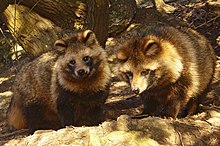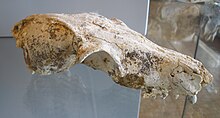Genus of carnivores
Nyctereutes [1] Temporal range:
5.332–0 Ma
PreꞒ
Ꞓ
O
S
D
C
P
T
J
K
Pg
N
Late Miocene - recent
Two Japanese raccoon dogs (N. viverrinus )
Scientific classification
Kingdom:
Animalia
Phylum:
Chordata
Class:
Mammalia
Order:
Carnivora
Family:
Canidae
Subfamily:
Caninae
Genus:
Nyctereutes Temminck , 1834[2]
Type species
Nyctereutes procyonoides [citation needed
Species
N. procyonoides N. viverrinus
Nyctereutes nyx, nykt- "night" + ereutēs "wanderer") is a genus of canid which includes only two extant species both known as raccoon dogs ; the common raccoon dog (Nyctereutes procyonoides ) and the Japanese raccoon dog (Nyctereutes viverrinus ).[1] Nyctereutes first entered the fossil record 5.5 million years ago (Mya ) in northern China . It was one of the earliest canines to arrive in the Old World . All but two species became extinct before the Pleistocene .[citation needed
Nyctereutes megamastoides fossil skull
Characteristics [ ] They are typically recognized by their short snouts, round craniums, and of course the shaping of their molars specifically the ration between M1 and M2. Nyctereutes mainly is considered an opportunistic carnivore, meaning they mainly feed on small mammals, fish, birds, insects, alongside occasional plants specifically roots. Their diet is mostly influenced through environmental factors.[3]
Species [ ] Extant species [ ] Nyctereutes procyonoides Nyctereutes viverrinus Fossil species [ ] †Nyctereutes abdeslami 3.6—1.8 Mya (Morocco)[4]
†Nyctereutes donnezani 9.0—3.4 Mya (Eastern Europe, Spain)
†Nyctereutes megamastoides (Europe)
†Nyctereutes sinensis 3.6 Mya—781,000 years ago (Eastern Asia)[5]
†Nyctereutes tingi
†Nyctereutes vinetorum
†Nyctereutes lockwoodi References [ ]
^ a b Wozencraft, C. W. (2005). "Order Carnivora" . In Wilson, D. E.; Reader, D. M. (eds.). Mammal Species of the World: A Taxonomic and Geographic Reference . Vol. 1 (3rd ed.). Johns Hopkins University Press. pp. 582–583. ISBN 978-0-8018-8221-0 ^ Temminck, C.J. (1838). "Over de geslachten Taphozous, Emballonura, Urocryptus en Diclidurus" [About the genera Taphozous, Emballonura, Urocryptus and Diclidurus]. Tijdschrift voor Natuurlijke Geschiedenis en Physiologie (in Dutch). 5 : 1–34. ^ Farjand, Arya; Zhang, Zhao-Qun; Liu, Wen-Hui; Jiao, Chen-Hui; Wang, Li-Hua (June 2021). "The evolution of Nyctereutes (Carnivora: Canidae) in the Nihewan Basin, Hebei, northern China". Palaeoworld . 30 (2): 373–381. doi :10.1016/j.palwor.2020.07.002 . S2CID 225565692 . ^ Paleobiology Database: ''Nyctereutes abdeslami basic info. ^ Paleobiology Database: ''Nyctereutes sinensis basic info.
Further reading [ ]
Extant Carnivora species
Kingdom: Animalia
Phylum: Chordata
Class: Mammalia
Infraclass: Eutheria
Superorder: Laurasiatheria
Nandiniidae
Nandinia
African palm civet (N. binotata )
Herpestidae (Mongooses)
Hyaenidae (Hyenas)
Crocuta
Spotted hyena (C. crocuta ) Hyaena
Striped hyena (H. hyaena ) Parahyaena Proteles
Felidae Large family listed below
Viverridae Large family listed below
Eupleridae Small family listed below
Family Felidae
Felinae
Acinonyx Caracal Catopuma
Bay cat (C. badia ) Asian golden cat (C. temminckii ) Felis Herpailurus
Jaguarundi (H. yagouaroundi ) Leopardus Leptailurus Lynx
Canada lynx (L. canadensis ) Eurasian lynx (L. lynx ) Iberian lynx (L. pardinus ) Bobcat (L. rufus ) Otocolobus Pardofelis
Marbled cat (P. marmorata ) Prionailurus Puma
Pantherinae
Panthera
Lion (P. leo ) Jaguar (P. onca ) Leopard (P. pardus ) Tiger (P. tigris ) Snow leopard (P. uncia ) Neofelis
Sunda clouded leopard (N. diardi ) Clouded leopard (N. nebulosa )
Family Viverridae
Paradoxurinae
Arctictis Arctogalidia
Small-toothed palm civet (A. trivirgata ) Macrogalidia
Sulawesi palm civet (M. musschenbroekii ) Paguma
Masked palm civet (P. larvata ) Paradoxurus
Hemigalinae
Chrotogale Cynogale
Otter civet (C. bennettii ) Diplogale Hemigalus
Banded palm civet (H. derbyanus )
Prionodontinae (Asiatic linsangs)
Viverrinae
Civettictis
African civet (C. civetta ) Genetta (Genets) Poiana Viverra Viverricula
Small Indian civet (V. indica )
Suborder Caniformia (cont. below)
Ursidae (Bears)
Ailuropoda
Giant panda (A. melanoleuca ) Helarctos Melursus Tremarctos
Spectacled bear (T. ornatus ) Ursus
American black bear (U. americanus ) Brown bear (U. arctos ) Polar bear (U. maritimus ) Asian black bear (U. thibetanus )
Mephitidae (Skunks )
Conepatus (Hog-nosed Mephitis
Hooded skunk (M. macroura ) Striped skunk (M. mephitis ) Mydaus Spilogale (Spotted skunks)
Procyonidae (Raccoons, coatis, olingos)
Bassaricyon (Olingos) Bassariscus Nasua (Coatis inclusive)
White-nosed coati (N. narica ) South American coati (N. nasua ) Nasuella (Coatis inclusive) Potos Procyon
Ailuridae
Ailurus
Himlayan red panda (A. fulgens ) Chinese red panda (A. styani )
Suborder Caniformia (cont. above)
Otariidae (Eared seals) (includes fur seals sea lions ) (Pinniped inclusive)
Arctocephalus Callorhinus
Northern fur seal (C. ursinus ) Eumetopias
Steller sea lion (E. jubatus ) Neophoca Otaria
South American sea lion (O. flavescens ) Phocarctos
New Zealand sea lion (P. hookeri ) Zalophus
Odobenidae (Pinniped inclusive)
Phocidae (Earless seals) (Pinniped inclusive)
Cystophora
Hooded seal (C. cristata ) Erignathus
Bearded seal (E. barbatus ) Halichoerus Histriophoca
Ribbon seal (H. fasciata ) Hydrurga
Leopard seal (H. leptonyx ) Leptonychotes
Weddell seal (L. weddellii ) Lobodon
Crabeater seal (L. carcinophagus ) Mirounga (Elephant seals)
Northern elephant seal (M. angustirostris ) Southern elephant seal (M. leonina ) Monachus
Mediterranean monk seal (M. monachus ) Neomonachus
Hawaiian monk seal (N. schauinslandi ) Ommatophoca Pagophilus
Harp seal (P. groenlandicus ) Phoca
Spotted seal (P. largha ) Harbor seal (P. vitulina ) Pusa
Canidae Large family listed below
Mustelidae Large family listed below
Family Canidae (includes dogs )
Atelocynus
Short-eared dog (A. microtis ) Canis
Golden jackal (C. aureus ) Domestic dog (C. familiaris ) Coyote (C. latrans ) African wolf (C. lupaster ) Wolf (C. lupus ) Eastern wolf (C. lycaon ) Red wolf (C. rufus ) Ethiopian wolf (C. simensis ) Cerdocyon
Crab-eating fox (C. thous ) Chrysocyon Cuon Lupulella Lycalopex Lycaon
African wild dog (L. pictus ) Nyctereutes Otocyon Speothos Urocyon
Gray fox (U. cinereoargenteus ) Island fox (U. littoralis ) Vulpes (Foxes )
Family Mustelidae
Helictidinae (Ferret-badgers)
Guloninae (Martens and wolverines)
Eira Gulo Martes (Martens)
American marten (M. americana ) Pacific marten (M. caurina ) Yellow-throated marten (M. flavigula ) Beech marten (M. foina ) Nilgiri marten (M. gwatkinsii ) European pine marten (M. martes ) Japanese marten (M. melampus ) Sable (M. zibellina ) Pekania
Ictonychinae (African polecats and grisons)
Galictis Ictonyx Lyncodon Poecilogale
African striped weasel (P. albinucha ) Vormela
Marbled polecat (V. peregusna )
Lutrinae (Otters)
Aonyx Enhydra Hydrictis
Spotted-necked otter (H. maculicollis ) Lontra Lutra
Eurasian otter (L. lutra ) Hairy-nosed otter (L. sumatrana ) Lutrogale
Smooth-coated otter (L. perspicillata ) Pteronura
Melinae (Eurasian badgers)
Mellivorinae
Mellivora
Honey badger (M. capensis )
Mustelinae (Weasels and minks)
Mustela (Weasels and ferrets )
Mountain weasel (M. altaica ) Stoat/Beringian ermine (M. erminea ) Steppe polecat (M. eversmannii ) Ferret (M. furo ) Haida ermine (M. haidarum ) Japanese weasel (M. itatsi ) Yellow-bellied weasel (M. kathiah ) European mink (M. lutreola ) Indonesian mountain weasel (M. lutreolina ) Black-footed ferret (M. nigripes ) Least weasel (M. nivalis ) Malayan weasel (M. nudipes ) European polecat (M. putorius ) American ermine (M. richardsonii ) Siberian weasel (M. sibirica ) Back-striped weasel (M. strigidorsa ) Neogale
Taxidiinae
Taxidea
American badger (T. taxus )

